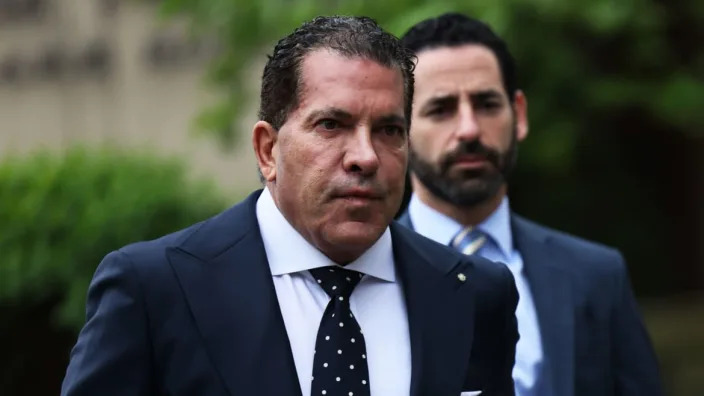Politico
The little-known group that’s saving Ukraine
Lara Seligman and Paul McLeary – May 1, 2023

RAMSTEIN AIR BASE, Germany — When U.S. Defense Secretary Lloyd Austin brings together the defense chiefs of more than 40 nations here in southwest Germany each month, the hours-long gathering typically ends the same way: Celeste Wallander, the Pentagon’s head of international security affairs, calls on each participant to read out what weapons their nation is ready to donate to Ukraine.
It’s a question — perhaps the question — that will help determine Ukraine’s future more than a year following Russia’s invasion.
And it’s made the monthly closed-door grouping of leaders — known by the anodyne bureaucratic title of the Ukraine Defense Contact Group — an under-the-radar yet central force in equipping the Ukrainian military with everything from precision rockets to main battle tanks. It’s also helped the nation create an ad hoc yet astonishingly modern military that would be capable of outgunning some long-standing NATO members.
But on the sidelines of the group’s April 21 meeting in a cavernous, wood-paneled ballroom here at the American-run Ramstein Air Base, it was clear that staying united — which the group has succeeded at for more than a year — will be an increasing challenge.
A number of fissures have emerged recently in the group, particularly over whether and when to send Western fighter jets to Ukraine, and delays in certain weapons shipments — most pressingly, German and Spanish tanks. Meanwhile, the mass transfer of weaponry to Kyiv has left donor nations worried about their own stockpiles, and recent meetings have started to turn to the issue of NATO allies reequipping themselves as well as sustaining the weapons donated to Ukraine for the long haul.
“We have done a lot already in terms of the donations, but now the question is more on sustainability,” Esa Pulkkinen, the permanent secretary, or deputy, in Finland’s defense ministry, said as military leaders gathered at Ramstein last month.
“Besides supporting Ukraine, we also need to replenish our own stocks, right?” one European diplomat said.
Austin, Joint Chiefs Chair Gen. Mark Milley and Ukrainian Defense Minister Oleksii Reznikov sit at a head table draped in white tablecloths, flanked by American and Ukrainian flags. Crystal chandeliers hang over their heads. Aides sip coffee and mingle in hushed voices on the sidelines.
The meeting starts, as always, with a battlefield update from the Ukrainians. The other members sit at two narrow tables perpendicular to the leaders’ table, forming three sides of an open rectangle. Each country is represented by a miniature flag next to its member’s microphone.
Austin leads the discussion, making opening and closing comments, but typically spends more time listening to the presentations. Wallander emcees, moving each presenter along. During the latest meeting, members devoted one 90-minute block to discussing sustainment and industrial base challenges; the entire meeting can last more than six hours.
The impetus for the Ramstein gatherings came about without fanfare early on in the conflict. While readying a secret trip to wartime Ukraine just a month after the Russian invasion, the people attending Austin’s daily 6:30 a.m. staff meeting on the third floor of the Pentagon — called a “policy op sync” and modeled off the twice-daily meetings he chaired during the Afghanistan evacuation — realized a major problem was brewing.
Kyiv had survived Russia’s initial onslaught, yet it was becoming clear that the U.S. and other countries would need to overcome past misgivings about arming Ukraine and commit for the long haul. In those early days, no one was coordinating the equipment that countries were quickly beginning to pledge, risking a serious miscalculation for the Western nations aiding Ukraine.
“I did a lot of phone calls talking to countries, ‘can you send this,’ and I think it was at that point that the idea developed that the secretary had, ‘no, we need to bring the key contributors to Ukraine together so we can understand what the scope of this is,’” said Wallander in an interview at the Pentagon.
Austin named it the Ukraine Defense Contact Group, which met on April 26, 2022, at Ramstein. It was the meeting — which was conceived and planned in about a week’s time — that kick-started the process of saving Ukraine.
Although disputes do break out between the participants, the sniping typically stays outside the room — a remarkable feat that members say is due to Austin’s steady leadership, calm presence and deep military knowledge. Austin’s attention to bilateral relations — including always giving countries public credit for their donations — has won him credibility, according to officials involved in the Ramstein meeting.
POLITICO spoke to 17 people directly involved in the discussions for this story, many of whom were granted anonymity to discuss the closed-door meetings.
Tensions brewing
The Ramstein meetings are typically scripted affairs, during which ministers read from prepared notes. But the orderly gatherings mask significant differences between the governments working to arm Ukraine. Eastern European countries such as Poland and Estonia have leaned forward in providing aid, while Germany and France often lag. The United States — specifically Austin — at times must straddle the two sides.
Meanwhile, Kyiv is constantly asking for more — and better — equipment. The ink was barely dry on the decision to send Abrams main battle tanks in January, for example, when Ukrainian officials renewed a push to receive F-16 fighter jets.
The fighter jet question is still a live issue, and the split between the various participants over whether to send Western warplanes was on display at the most recent Ramstein meeting. While Austin and other U.S. officials have been clear that they do not believe F-16s are necessary for the current fight, others say that the group is still debating the issue.
“There’s an ongoing discussion about also other types of jets,” said NATO Secretary General Jens Stoltenberg, speaking to reporters on the balcony while participants stretched their legs during a break in the meeting.
Still, others seemed sure that Western jets will be heading to Kyiv at some point.
“Western fighters will be a part of the Western military integration of the Ukraine armed forces, whether the time is now or perhaps later,” Pulkkinen said.
President Joe Biden has at times called on Austin to use the Ramstein meeting to appeal to his counterparts directly to do more to help Ukraine. In January, after German Chancellor Olaf Scholz refused to send Leopard tanks without the U.S. first sending its own Abrams tanks, the president turned to Austin to make one final appeal to his brand-new German counterpart, Defense Minister Boris Pistorius, at that month’s gathering.
Biden had reason to hope Austin could clinch a deal. Throughout the conflict, the defense secretary has consistently managed to turn his relationships into concrete aid for Ukraine. Early in the war, Austin personally brokered a deal with Slovakia’s defense minister for the eastern European country to send one of its Russian-made S-300 air defense systems, in exchange for the U.S. repositioning one of its Patriot missile systems to Slovakia.
But this time, Austin could not break through Berlin’s hesitation. Ultimately, Biden ended up greenlighting the Abrams, paving the way for Germany to send the Leopards.
Some nations are still frustrated with the slow pace of Berlin’s donations.
Germany should be “sending more weapons, sending more ammunition, and giving more money to Ukraine, because they are the richest and the biggest country by far,” Polish Prime Minister Mateusz Morawiecki told POLITICO. He added that the Germans “were not as generous as they should have been” with Ukraine since the start of the war.
“Collectively we have to, and we can, do more. We all understand what is at stake,” Estonian Defense Minister Hanno Pevkur told POLITICO at Ramstein. Referring to his own government, he said, “we have done a lot definitely.”
Despite differences between the various countries, participants said Austin’s consistency and attention to personal relationships keeps each gathering running smoothly and is the reason the members return to Ramstein time and again to discuss new ways to support Ukraine.
Canadian Defense Minister Anita Anand recalled how Austin encouraged her to donate some of Canada’s 82 Leopard 2 tanks. Parting with those tanks was “no small thing,” she said. Her personal relationship with Austin — who she calls a “constant gentleman” — was crucial in Ottawa’s decision to ultimately send four tanks.
“This is why we have to gather. This is why we have to come together and that’s to say why we have to help Ukraine,” Pevkur said.
But the tensions over the tank decision could foreshadow more angst in the months ahead as Ukraine continues to suck up billions in munitions. Replacing all of that takes time, planning and significant investments.
New challenges
The last several meetings of the Ukraine group have seen allies starting to think hard about how to find the money — and the industrial capacity — to replace the gear sent to battle the Russians.
“It still is the only effective format when it comes to coordination of deliveries but also of the needed materiel,” one senior European diplomat said. “Regardless [of] the differences in opinion.”
Plus, they need to wade through a thicket of parochial interests and find a way to do something even more difficult: jointly manufacture ammunition and other materiel as the war in Ukraine grinds on and individual production lines reach their breaking point.
Another divisive issue is how defense spending is split among allies. NATO’s annual report released in March showed that despite an entire year of pledging increased defense spending, only seven countries out of 30 have met the nine-year-old goal of spending 2 percent of their GDP on defense — two fewer countries than hit the mark in 2021.
Other trends have emerged at the Ramstein meetings that have also frustrated some participants. According to the two European diplomats, a handful of countries have consistently promised equipment that never seems to arrive but is recycled at each meeting with no timeline attached.
“They somehow never mention when that will happen, and then we have another Ramstein format happen and you are still claiming the same thing,” one of the officials said.
Despite these emerging fissures, sticking with Kyiv for the long haul has been a talking point for all NATO allies since the start of the war, and even with some delays in promised equipment, donations continue to flow over the border to Kyiv. And 14 months in, with new spring and summer offensives on the way, there has been no change in that rhetoric.
“We cannot let war fatigue in our societies and politics take hold,” Latvian Defense Minister Inara Murniece said while visiting Washington just before the latest Ramstein meeting. “We must grab this momentum and do everything possible to make the spring and summer Ukrainian offensive successful. We can’t lose this moment.”
Lili Bayer in Brussels contributed to this report.








